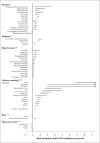Shared Risk Factors in Cardiovascular Disease and Cancer
- PMID: 26976915
- PMCID: PMC4800750
- DOI: 10.1161/CIRCULATIONAHA.115.020406
Shared Risk Factors in Cardiovascular Disease and Cancer
Abstract
Cardiovascular disease (CVD) and cancer are the 2 leading causes of death worldwide. Although commonly thought of as 2 separate disease entities, CVD and cancer possess various similarities and possible interactions, including a number of similar risk factors (eg, obesity, diabetes mellitus), suggesting a shared biology for which there is emerging evidence. Although chronic inflammation is an indispensable feature of the pathogenesis and progression of both CVD and cancer, additional mechanisms can be found at their intersection. Therapeutic advances, despite improving longevity, have increased the overlap between these diseases, with millions of cancer survivors now at risk of developing CVD. Cardiac risk factors have a major impact on subsequent treatment-related cardiotoxicity. In this review, we explore the risk factors common to both CVD and cancer, highlighting the major epidemiological studies and potential biological mechanisms that account for them.
Keywords: cardiology; cardiovascular diseases; clinical oncology; risk factors.
© 2016 American Heart Association, Inc.
Conflict of interest statement
Figures

References
-
- Hoyert DL, Xu J. Deaths: preliminary data for 2011. Natl Vital Stat Reports From Centers Dis Control Prev Natl Cent Heal Stat Natl Vital Stat Syst. 2012;61:1–51. - PubMed
-
- American Cancer Society. Cancer Facts & Figures 2014. Atlanta: American Cancer Society; 2014.
-
- Heidenreich PA, Trogdon JG, Khavjou OA, Butler J, Dracup K, Ezekowitz MD, Finkelstein EA, Hong Y, Johnston SC, Khera A, Lloyd-Jones DM, Nelson SA, Nichol G, Orenstein D, Wilson PWF, Woo YJ. Forecasting the Future of Cardiovascular Disease in the United States A Policy Statement From the American Heart Association. Circulation. 2011;123:933–944. - PubMed
-
- Libby P. Inflammation and cardiovascular disease mechanisms. Am J Clin Nutr. 2006;83:456S–460S. - PubMed
Publication types
MeSH terms
Substances
Grants and funding
LinkOut - more resources
Full Text Sources
Other Literature Sources

